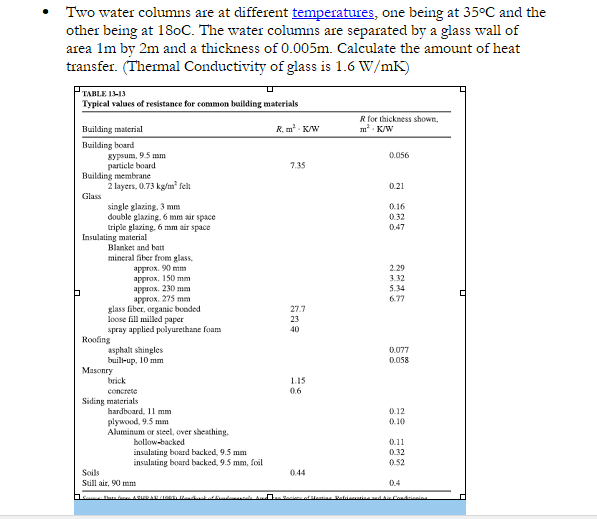Two water columns are at different temperatures, one being at 35°C and the other being at 18oC. The water columns are separated by a glass wall of area Im by 2m and a thickness of 0.005m. Calculate the amount of heat transfer. (Thermal Conductivity of glass is 1.6 W/mK) TABLE 13-13 Typical values of resistance for common building materials R for thickness shown, m K/W Building material R, m K/W Building board Kypoum, 9.5 mm particle board Building membrane 2 layers, 0.73 kg/m° felt 0.056 7.35 0.21 Glass single glazing, 3 mm double glazing. 6 mm air space triple glazing, 6 mm air space 0.16 0.32 047 Insulating material Blanket and batt mineral fiber from glass, approx. 90 mm approx. 150 mm approx. 230 mm approx. 275 mm glass fiber, organic bonded loose fill milled paper spray applied polyurethane foam 2.29 3.32 5.34 6.77 27.7 23 40 Roofing asphalt shingles buil-up, 10 mm 0.077 0.058 Masonry brick 1.15 concrete 0.6 Siding materials hardboard, 11 mm 0.12 0.10 plywood, 9.5 mm Aluminum or steel, over sheathing. bollow-backed insulating board backed, 9.5 mm insulating board backed, 9.5 mm, foil 0.11 0.32 0.52 Soils 0.44 Still air, 90 mm 0.4 Socie of esti Retii d Condienin
Two water columns are at different temperatures, one being at 35°C and the other being at 18oC. The water columns are separated by a glass wall of area Im by 2m and a thickness of 0.005m. Calculate the amount of heat transfer. (Thermal Conductivity of glass is 1.6 W/mK) TABLE 13-13 Typical values of resistance for common building materials R for thickness shown, m K/W Building material R, m K/W Building board Kypoum, 9.5 mm particle board Building membrane 2 layers, 0.73 kg/m° felt 0.056 7.35 0.21 Glass single glazing, 3 mm double glazing. 6 mm air space triple glazing, 6 mm air space 0.16 0.32 047 Insulating material Blanket and batt mineral fiber from glass, approx. 90 mm approx. 150 mm approx. 230 mm approx. 275 mm glass fiber, organic bonded loose fill milled paper spray applied polyurethane foam 2.29 3.32 5.34 6.77 27.7 23 40 Roofing asphalt shingles buil-up, 10 mm 0.077 0.058 Masonry brick 1.15 concrete 0.6 Siding materials hardboard, 11 mm 0.12 0.10 plywood, 9.5 mm Aluminum or steel, over sheathing. bollow-backed insulating board backed, 9.5 mm insulating board backed, 9.5 mm, foil 0.11 0.32 0.52 Soils 0.44 Still air, 90 mm 0.4 Socie of esti Retii d Condienin
Principles of Heat Transfer (Activate Learning with these NEW titles from Engineering!)
8th Edition
ISBN:9781305387102
Author:Kreith, Frank; Manglik, Raj M.
Publisher:Kreith, Frank; Manglik, Raj M.
Chapter11: Heat Transfer By Radiation
Section: Chapter Questions
Problem 11.45P
Related questions
Question

Transcribed Image Text:Two water columns are at different temperatures, one being at 35°C and the
other being at 18oC. The water columns are separated by a glass wall of
area Im by 2m and a thickness of 0.005m. Calculate the amount of heat
transfer. (Thermal Conductivity of glass is 1.6 W/mK)
TABLE 13-13
Typical values of resistance for common building materials
R, m K/W
R for thickness shown,
m K/W
Building material
Building board
Eypsum, 9.5 mm
particle board
Building membrane
2 layers, 0.73 kg/ns³ felt
0.056
7.35
0.21
Glass
single glazing. 3 mm
double glazing. 6 mm air space
triple glazing, 6 mm air space
0.16
0.32
0.47
Insulating material
Blanket and batt
mineral fiber from glass,
approx. 90 mm
approx. 150 mm
approx. 230 mm
approx. 275 mm
glass fiber, organic bonded
loose fill milled paper
spray applied polyurethane foam
Roofing
2.29
3.32
5.34
6.77
27.7
23
40
asphalt shingles
buil-up, 10 mm
0.077
0.058
Masonry
brick
1.15
concrete
0.6
Siding materials
hardboard, 1l mm
0.12
plywood, 9.5 mm
Aluminum or steel, over sheathing.
0.10
bollow-backed
0.11
insulating board backed, 9.5 mm
insulating board backed, 9.5 mm, foil
0.32
0.52
Soils
044
Still air, 90 mm
0.4
Expert Solution
This question has been solved!
Explore an expertly crafted, step-by-step solution for a thorough understanding of key concepts.
This is a popular solution!
Trending now
This is a popular solution!
Step by step
Solved in 2 steps with 1 images

Knowledge Booster
Learn more about
Need a deep-dive on the concept behind this application? Look no further. Learn more about this topic, mechanical-engineering and related others by exploring similar questions and additional content below.Recommended textbooks for you

Principles of Heat Transfer (Activate Learning wi…
Mechanical Engineering
ISBN:
9781305387102
Author:
Kreith, Frank; Manglik, Raj M.
Publisher:
Cengage Learning

Principles of Heat Transfer (Activate Learning wi…
Mechanical Engineering
ISBN:
9781305387102
Author:
Kreith, Frank; Manglik, Raj M.
Publisher:
Cengage Learning